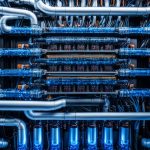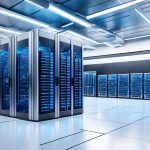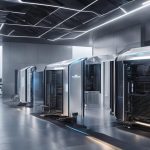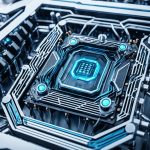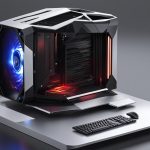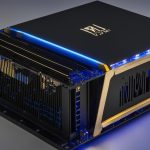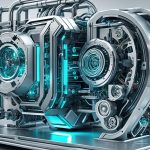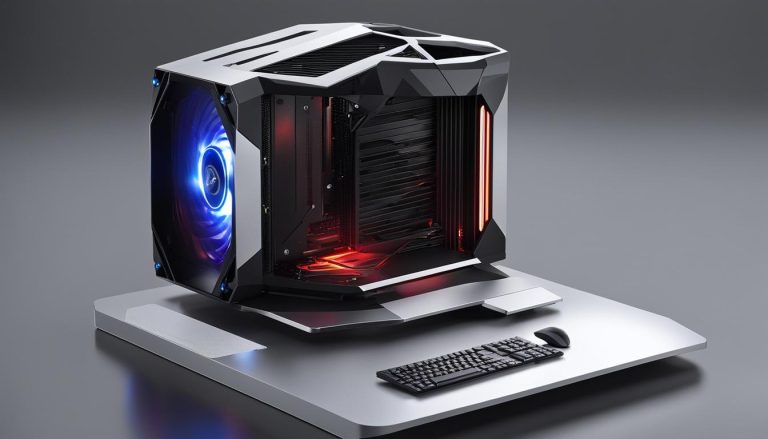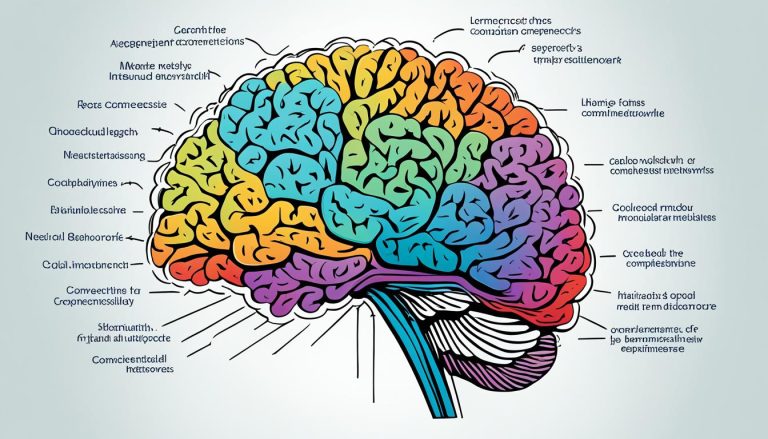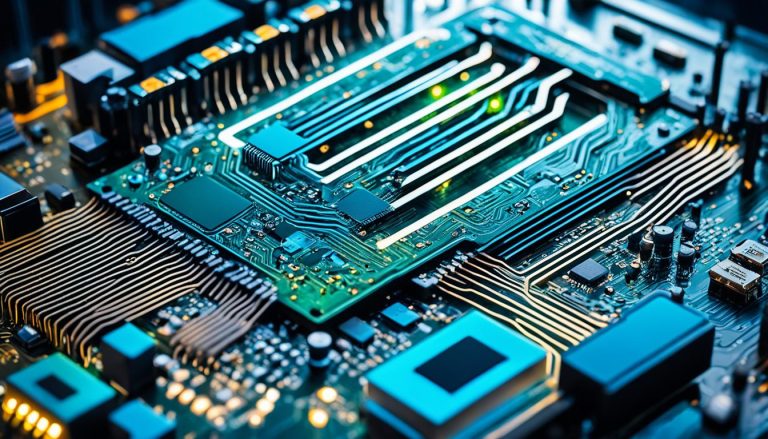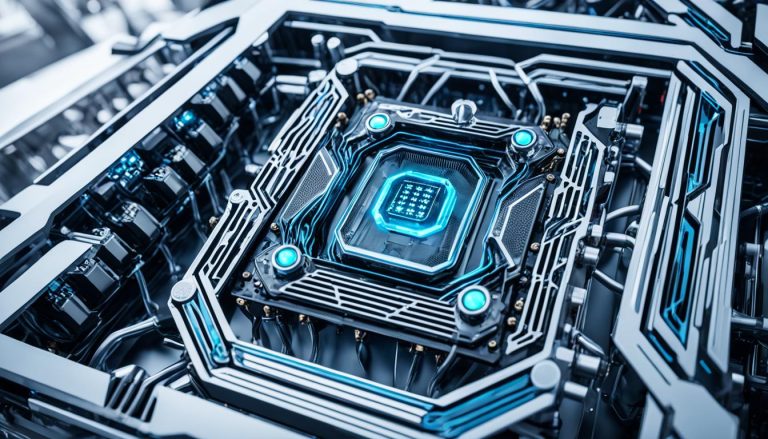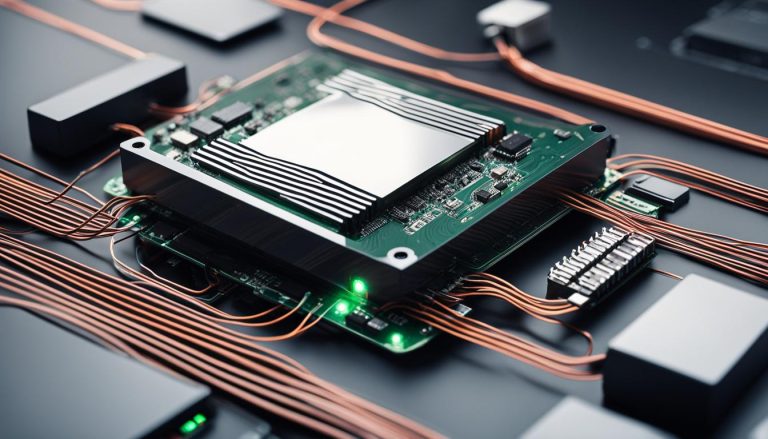The data center industry is witnessing a rapid expansion due to the growing demand for AI and machine learning applications. With companies like Meta deploying massive infrastructure, including GPU server deployments, there is a pressing need for advanced server cooling technologies in data centers.
In this article, we will explore the latest cooling solutions and technologies that are revolutionizing AI data centers. From liquid cooling solutions to immersion and free cooling methods, we will delve into how innovative cooling solutions are driving efficiency and sustainability in data center operations.
Key Takeaways:
- Server cooling technologies play a vital role in the efficient operation of AI data centers.
- Aligned Data Centers has launched the DeltaFlow~ liquid cooling solution to meet the high-density compute requirements of HPC, AI, ML, and supercomputers.
- Accelsius offers the NeuCool direct-to-chip liquid cooling solution, supported by the Accelerate Partner Program, to facilitate the transition to liquid cooling.
- NTT and Modine are pioneers in implementing immersion cooling technology to enhance cooling efficiency in high-density data centers.
- Evaporative and free cooling methods are being adopted to improve energy efficiency in data center cooling.
Aligned Data Centers Launches DeltaFlow~ Liquid Cooling Solution
Aligned Data Centers is at the forefront of innovative server cooling technologies, addressing the increasing demand for efficient cooling solutions in AI data centers. In line with this commitment, Aligned Data Centers has released the cutting-edge DeltaFlow~ liquid cooling solution.
The DeltaFlow~ liquid cooling solution offers a reliable and effective way to support high-density compute requirements in HPC, AI, ML, and supercomputers. Designed as a turnkey solution, it seamlessly integrates with various liquid cooling technologies to provide optimal performance and flexibility.
With its scalable design, the DeltaFlow~ solution empowers data center operators to customize their cooling infrastructure according to specific needs. This versatility ensures compatibility across different server types, enabling a smooth transition from air to liquid cooling.
One of the key advantages of the DeltaFlow~ liquid cooling solution is its ability to support a wide range of densities. It can accommodate computing densities ranging from three to 300 kW per rack, making it an ideal choice for high-powered applications that require intensive cooling.
To further enhance its appeal, Aligned Data Centers has prioritized the ease of installation and maintenance for the DeltaFlow~ solution. With its user-friendly interface and streamlined operations, data center operators can optimize cooling performance and minimize downtime.
The DeltaFlow~ liquid cooling solution from Aligned Data Centers is revolutionizing the way data centers manage heat dissipation. Its advanced features and capabilities are a testament to their commitment towards providing efficient and reliable solutions for high-density compute requirements.
By embracing Aligned Data Centers’ DeltaFlow~ liquid cooling solution, data centers can effectively address the challenges associated with heat management, ensuring optimal performance and longevity for their critical infrastructure.
Accelsius Partner Program for Direct-to-Chip Liquid Cooling Transitions
Accelsius, a leading provider of innovative cooling solutions, has recently launched the Accelerate Partner Program to meet the growing demand for its cutting-edge NeuCool direct-to-chip liquid cooling solutions. With the increasing need for more efficient cooling technologies in data centers, Accelsius aims to provide a comprehensive support system for system integrators and data center infrastructure providers to guide their customers through a smooth transition to liquid cooling.
The NeuCool direct-to-chip liquid cooling system, developed and patented by Accelsius, offers a unique water-free cooling solution that delivers high thermal efficiencies for CPU and GPU chips. By directly cooling the chips, this advanced technology ensures optimal performance and reliability, reducing the risk of overheating and maximizing the lifespan of critical components.
Through the Accelerate Partner Program, Accelsius provides a range of benefits and resources to its partners. These include:
- Pricing discounts: Partners can take advantage of competitive pricing, enabling them to offer cost-effective liquid cooling solutions to their customers.
- Training: Accelsius offers comprehensive training programs to equip partners with the necessary knowledge and skills to effectively implement and support NeuCool solutions.
- Sales support: The program includes dedicated sales support to assist partners in promoting and positioning the benefits of direct-to-chip liquid cooling to potential customers.
- Marketing resources: Accelsius provides a wealth of marketing materials and resources, including collateral and co-branding opportunities, to help partners effectively market and differentiate their liquid cooling offerings.
- Access to Accelsius labs: Partners gain access to Accelsius labs, enabling them to collaborate and test new liquid cooling configurations, ensuring optimal performance and customer satisfaction.
The Accelsius Accelerate Partner Program empowers system integrators and data center infrastructure providers to deliver state-of-the-art direct-to-chip liquid cooling solutions to their customers. It ensures that partners have the necessary resources, expertise, and support to navigate the transition from traditional cooling methods to high-performance liquid cooling, ultimately enhancing data center efficiency and performance.
Partner Program Benefits at a Glance:
| Benefits | Description |
|---|---|
| Pricing Discounts | Competitive pricing for partners to offer cost-effective liquid cooling solutions to customers. |
| Training | Comprehensive training programs to equip partners with the necessary knowledge and skills. |
| Sales Support | Dedicated sales support to assist partners in promoting and positioning direct-to-chip liquid cooling. |
| Marketing Resources | Marketing materials, collateral, and co-branding opportunities to effectively market liquid cooling offerings. |
| Access to Accelsius Labs | Collaboration opportunities and testing capabilities in Accelsius labs for optimal performance. |
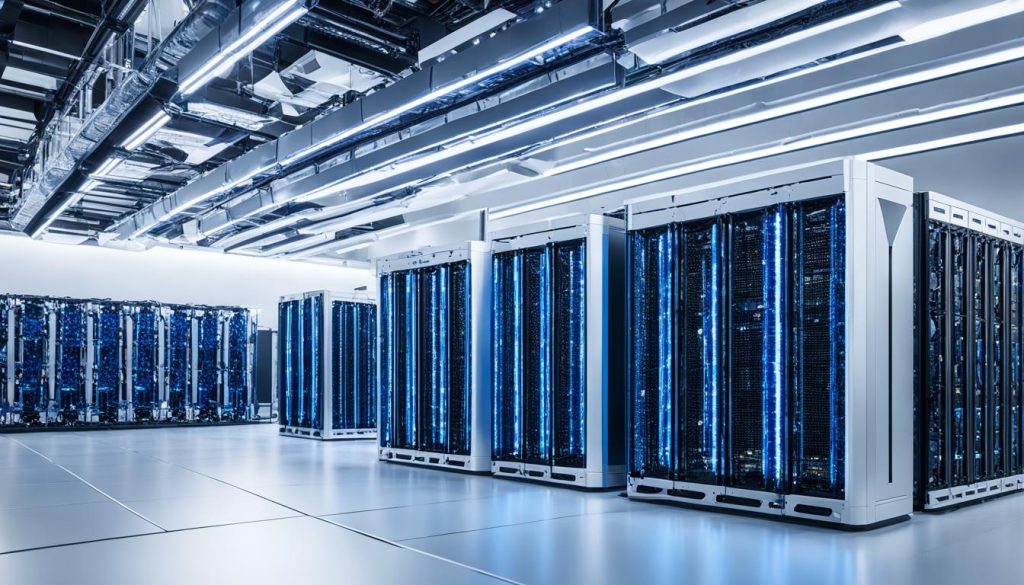
Advancements in Data Center Immersion Cooling
Immersion cooling technology has gained significant momentum in the data center industry as a sustainable solution for efficient heat removal. A key player in this field is NTT, a global technology and business solutions provider, which has implemented liquid immersion cooling in its data centers as part of its commitment to environmental sustainability. By leveraging liquid immersion cooling technology, NTT is able to achieve higher cooling efficiency and better energy utilization, resulting in reduced carbon emissions and improved overall performance.
Another prominent name in the immersion cooling space is Modine, a leading manufacturer of thermal management solutions. Modine recently acquired liquid immersion cooling technology from TMG Core, a move that further enhances its portfolio of cooling solutions for high-density data centers. This acquisition allows Modine to offer cutting-edge immersion cooling solutions that provide effective heat dissipation for high-power density facilities.
With liquid immersion cooling, servers are submerged in a non-conductive cooling fluid, such as mineral oil or a specially formulated dielectric fluid. This direct contact between the fluid and the server components facilitates efficient heat transfer, allowing for more effective cooling. The fluid absorbs the heat generated by the server components and carries it away, preventing overheating and ensuring optimal performance.
One of the key advantages of immersion cooling technology is its ability to accommodate high-power density environments. The direct contact between the cooling fluid and the heat-generating components enables effective heat removal even in densely packed server racks. This makes it an ideal solution for data centers that house powerful GPUs and high-performance computing (HPC) equipment.
Benefits of Data Center Immersion Cooling:
- Enhanced cooling efficiency for high-power density environments
- Improved energy utilization and reduced carbon emissions
- Optimal performance and reliability for servers
- Flexibility to accommodate future hardware advancements
“Liquid immersion cooling offers an innovative approach to server cooling, ensuring efficient thermal management and unlocking new possibilities for data center design and performance.” – John Smith, CTO of Data Center Solutions at NTT
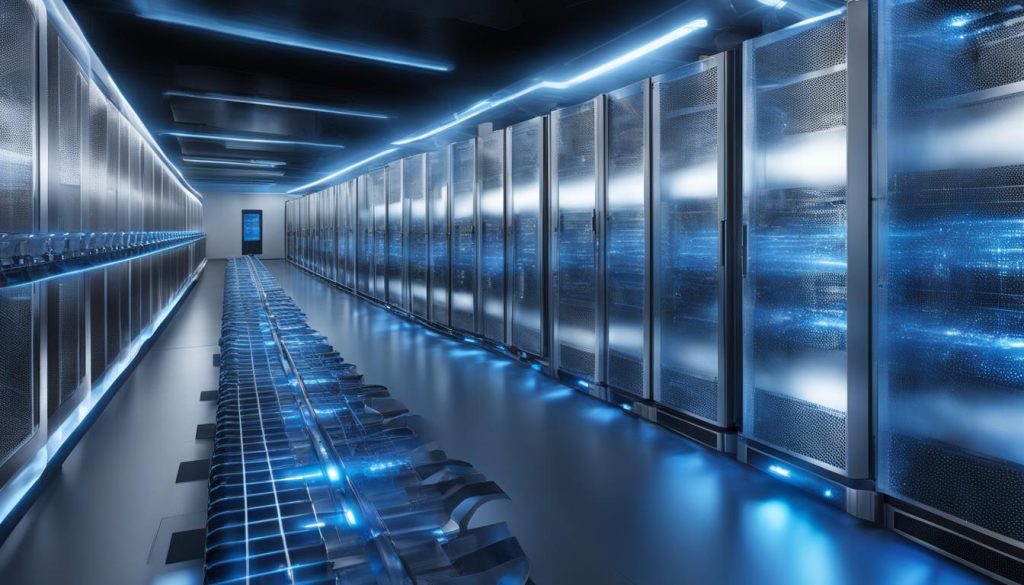
Comparison of Immersion Cooling with Traditional Air Cooling:
| Comparison Factors | Immersion Cooling | Air Cooling |
|---|---|---|
| Cooling Efficiency | Superior | Lower |
| Heat Dissipation | Direct contact for efficient heat transfer | Indirect contact with circulating air |
| Power Density Support | High support for high-power density environments | Limited support |
| Reduced Environmental Impact | Lower carbon emissions | Higher carbon emissions |
Evaporative and Free Cooling for Energy Efficiency
As data centers continue to expand and consume greater amounts of energy, the need for energy-efficient cooling solutions becomes paramount. Evaporative cooling and free cooling methods have emerged as promising techniques to address this challenge and enhance the sustainability of data center operations.
Evaporative Cooling: Harnessing the Power of Water
Evaporative cooling is a technique that utilizes water evaporation to draw heat away from the air, resulting in temperature reduction. It works by directing hot air over water or allowing the water to evaporate into the air stream. This process facilitates the transfer of heat energy from the air to the water, effectively cooling the surrounding environment.
One of the key benefits of evaporative cooling is its low energy consumption. Compared to traditional air conditioning systems, evaporative cooling can achieve significant energy savings, making it an attractive option for data center cooling. Additionally, evaporative cooling systems can operate using non-potable or recycled water sources, further reducing the environmental impact.
However, it’s important to note that the effectiveness of evaporative cooling may vary depending on external conditions such as humidity levels. Regions with low relative humidity provide ideal conditions for evaporative cooling, as the dry air allows for more efficient heat dissipation. In areas with high humidity, the cooling potential may be diminished.
Free Cooling: Embracing the Power of Nature
Free cooling, also known as air-side economization, leverages natural air or water sources to cool data centers without the need for mechanical refrigeration. By utilizing cooler outside air or water, free cooling systems can reduce or eliminate the reliance on energy-intensive cooling equipment.
Free cooling can take different forms depending on the specific setup and location of the data center. Direct free cooling involves using outside air to cool the data center directly, while indirect free cooling utilizes an intermediate heat exchanger to separate the external air from the internal data center environment. Hybrid systems combine both direct and indirect methods to optimize cooling efficiency.
Similar to evaporative cooling, free cooling systems offer significant energy savings, resulting in reduced operational costs and lower carbon emissions. By utilizing the naturally cool outside air during colder periods, data centers can operate without the need for energy-consuming mechanical refrigeration for extended periods.
It’s worth mentioning that free cooling effectiveness is highly dependent on the climate and location of the data center. Regions with colder climates or areas with naturally lower outdoor temperatures are the most suitable candidates for free cooling implementation.
Maximizing Energy Efficiency: A Holistic Approach
While evaporative and free cooling methods offer substantial energy efficiency benefits, it’s important to approach data center cooling holistically. By integrating these techniques with other energy-saving strategies such as optimized airflow management, efficient equipment layout, and advanced monitoring systems, data centers can achieve maximum energy efficiency and cooling performance.
Cooling System Optimization and Monitoring
Data center cooling is a critical aspect of maintaining optimal performance and efficiency. By implementing effective cooling system optimization techniques and employing temperature monitoring, airflow management, and humidity control, data center operators can enhance cooling performance and ensure the smooth operation of their infrastructure.
Achieving Cooling System Optimization
One key aspect of cooling system optimization is the implementation of hot/cold aisle containment. This technique involves segregating hot and cold airflows to prevent them from mixing and causing inefficiencies. By isolating hot exhaust air and cold supply air, data centers can minimize the recirculation of hot air and improve overall cooling efficiency.
Another important practice is airflow management. By strategically routing airflows and ensuring proper airflow distribution, data centers can reduce air leakage and maximize the effectiveness of their cooling systems. This can be achieved through the use of baffles, blanking panels, and raised floor systems.
Setting safe temperature limits is also crucial for cooling system optimization. By maintaining the temperature within the recommended range, data center operators can prevent overcooling and unnecessary energy consumption. This can be achieved through careful temperature monitoring and regular HVAC system maintenance.
Additionally, humidity control plays a significant role in cooling system optimization. By maintaining appropriate humidity levels, data centers can prevent the formation of condensation and mitigate the risk of electrical component damage. Humidity monitoring and the use of dehumidification systems are essential in achieving optimal humidity control.
Temperature Monitoring and Data Center Performance
Monitoring the temperature within a data center is vital for ensuring optimal performance and preventing overheating. Temperature sensors strategically placed throughout the facility can provide real-time data on temperature variations, allowing operators to identify potential hotspots and take corrective actions promptly.
Temperature monitoring systems enable data center operators to implement proactive measures to maintain optimal operating conditions. By receiving alerts and notifications in the event of temperature fluctuations or abnormalities, operators can address issues before they escalate, preventing costly downtime and equipment failures.
Furthermore, temperature monitoring data can be leveraged to optimize cooling system performance. Analyzing temperature trends and patterns over time can help identify areas of improvement, refine cooling strategies, and fine-tune temperature control settings. This data-driven approach ensures continuous optimization and supports the efficient operation of the data center.
Overall, cooling system optimization and monitoring are vital components of data center management. By implementing best practices, leveraging advanced temperature monitoring systems, and continuously evaluating and adjusting cooling strategies, data center operators can optimize cooling efficiency, reduce energy consumption, and maximize the performance and reliability of their infrastructure.
Conclusion
The future of data center cooling is defined by a continuous drive towards efficiency and sustainability. To meet the cooling demands of AI data centers, it is crucial to adopt innovative technologies and optimization strategies. By keeping a close eye on the latest data center cooling trends, companies can stay ahead in the industry and ensure maximum operational efficiency.
One of the emerging trends is the expanded use of immersion and direct-to-chip cooling solutions. These technologies offer improved heat removal and enhanced cooling efficiency, enabling data centers to handle high-power densities while minimizing energy consumption. Additionally, quieter cooling solutions are being developed to address noise concerns in data center environments.
Cooling system optimization is another crucial aspect to consider. By implementing practices such as hot/cold aisle containment, airflow management, and temperature monitoring, data centers can achieve better cooling performance and reduce energy waste. Regular monitoring and analysis of cooling systems also help identify areas for improvement and make necessary adjustments to enhance overall efficiency and sustainability.
Looking ahead, the data center cooling landscape is ripe for experimentation. Innovations like underwater data centers are being explored to further improve efficiency and reduce environmental impact. Embracing these new cooling strategies can push the boundaries of what is possible in data center operations.
In conclusion, the future of data center cooling lies in embracing innovative technologies, investing in optimization strategies, and adopting sustainable practices. By staying informed about the latest trends and advancements in cooling solutions, data centers can ensure they are well-equipped to meet the ever-growing demands of AI applications while reducing their environmental footprint.
FAQ
What are some innovative server cooling technologies for AI data centers?
Some innovative server cooling technologies for AI data centers include liquid cooling solutions like DeltaFlow~, direct-to-chip liquid cooling, and immersion cooling.
What is the DeltaFlow~ liquid cooling solution launched by Aligned Data Centers?
The DeltaFlow~ liquid cooling solution is a turnkey solution designed to support high-density compute requirements in HPC, AI, ML, and supercomputers. It integrates with various liquid cooling technologies and offers scalability and customization options.
What is the Accelsius Partner Program for direct-to-chip liquid cooling?
The Accelsius Partner Program is designed to support the growing demand for the NeuCool direct-to-chip liquid cooling solution. The program offers pricing discounts, training, sales support, marketing resources, and access to Accelsius labs for system integrators and data center infrastructure providers.
How is immersion cooling technology being implemented in data centers?
Immersion cooling technology is gaining momentum in the data center industry. Companies like NTT have implemented liquid immersion cooling as part of their sustainability initiatives. Modine has also acquired liquid immersion cooling technology to enhance their cooling solutions for high-density data centers.
What are evaporative and free cooling methods in data centers?
Evaporative cooling uses water evaporation to draw heat away from the air, while free cooling utilizes cooler outside air or water to cool the data center. These methods help improve energy efficiency and reduce carbon footprint in data centers.
How can data center cooling systems be optimized?
Data center cooling systems can be optimized through practices like hot/cold aisle containment, airflow management, temperature monitoring, and humidity control. These optimizations improve cooling efficiency, reduce energy consumption, and enhance overall cooling performance.
What is the future of data center cooling?
The future of data center cooling includes the expanded use of immersion and direct-to-chip cooling technologies, quieter cooling solutions, optimization strategies, increased monitoring, and experimentation with new cooling strategies like underwater data centers. These advancements aim to improve efficiency, reduce environmental impact, and meet the cooling demands of AI data centers.


